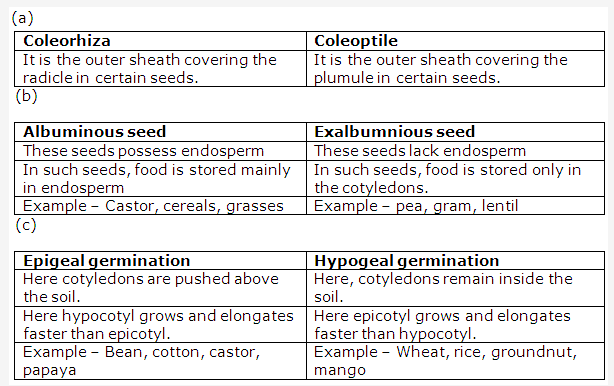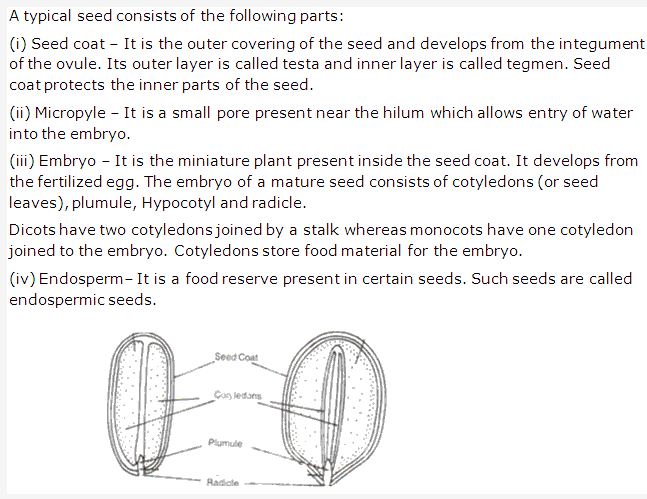Frank ICSE Solutions for Class 9 Biology – Seeds: Structure and Germination
PAGE NO: 78
Solution 1:
(a) Seed is defined as a fertilized mature ovule which possesses an inactive embryo and reserve food for its further development.
(b) The process by which the dormant embryo of the seed resumes active growth and forms a seedling is known as germination.
Solution 2:
(a) Albuminous seed – In some dicotyledons and monocotyledons, the
food is stored mainly in the endosperm. Such seeds are called albuminous seeds. Example – Seeds of castor, cereals and grasses.
(b) Dormancy – Seed dormancy is a condition of plant seeds that prevents germination under optimal environmental conditions. Here the seed is in a state of apparent inactivity and will not grow even if favorable conditions are provided, until a definite time has elapsed.
(c) Hypogeal germination – In this germination, the seed remains inside the soil since epicotyl elongates faster than hypocotyl. Hence the cotyledons remain inside the soil. Example – Wheat, rice, pea, mango.
(d) Epigeal germination – It is a type of germination in which cotyledons are pushed above the soil into the air and light. This occurs due to rapid growth and elongation of the hypocotyl. Example – Bean, cotton, castor, papaya, onion, tamarind.
Solution 3:
This is because the seed is in a state of dormancy. In this case, even if all the favorable conditions are provided, the seed remains in a state of apparent inactivity and only germinates after a definite time has elapsed.
Solution 4:
(a) Seed coat is the outer covering of seed. It protects the inner contents of the seed.
(b) Micropyle allows entry of water into the embryo.
(c) Endosperm contains stored food mostly as starch.
(d) Cotyledons store food material for the embryo.
Solution 5:
(a) Plumule
(b) Coleorhiza
(c) Endosperm
(d) Micropyle
(e) Root and shoot
(f) Endosperm
(g) Epigeal germination
(h) Hypogeal germination
(i) Orchis seed
(j) Seed of Lodoicea moldivica
PAGE NO: 79
Solution 6:

Solution 7:
(a) castor, papaya
(b) grasses, wheat
(c) pea, mango
(d) wheat, rice
Solution 8:
The factors necessary for germination are:
- Water – Water is essential for seed germination since protoplasm becomes active only when saturated with water. Water facilitates the necessary chemical changes in food material. Also enzymatic reaction occurs only in the water medium. Water when imbibed by the seed coat makes it soft and swollen. Then the seed coat bursts open, helping the embryo come out easily.
- Temperature – A suitable temperature is essential for seed germination since many physiological processes occur within the seed during germination. Seeds fail to germinate below 0?C or above 45?C. Optimum temperature for seed germination is 15-30?C.
- Oxygen – During germination, embryo resumes growth and for this energy is required. This energy comes from the oxidation of food material stored in the endosperm or cotyledons. This process requires oxygen.
Solution 9:
Apparatus required for three beans experiment are beaker, bean seeds and wooden piece.
The air-dried seeds are attached to a piece of wood, one at each end and one in the middle. This is then placed in a beaker and water is poured into it till the middle seed is half immersed in it. The beaker is then left in a warm place for a couple of days. From time to time, water is added to maintain the original level.
It is observed that after a couple of days that the bean in the middle germinates normally since it has sufficient water, oxygen and temperature. The bottom seed gets sufficient water and temperature but not oxygen hence it may develop a radicle but doesn’t grow further. The upper seed gets oxygen and temperature but not water and hence fails to germinate.
This experiment shows that water, temperature and oxygen are essential for seed germination and that germination will not occur if any one of these factors are absent.
Solution 10:
If the seeds are sown too deep in the soil, they may not get sufficient oxygen required for respiration and hence will fail to germinate.
Solution 11:

Solution 12:
(i) (d) in endosperm
(ii) (d) castor bean
(iii) (d) all the above
(iv) (d) maize
(v) (a) double coconut
(vi) (b) germination
BiologyChemistryPhysicsMaths
